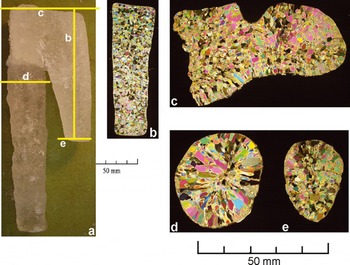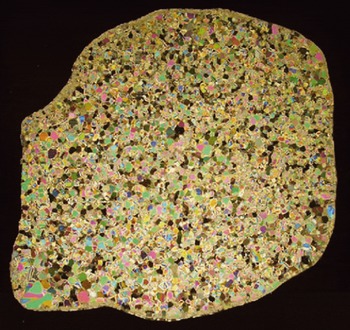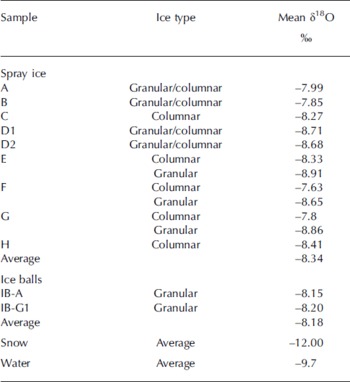Lake Inawashiro, located on the main island of Japan, exhibits interesting natural lake ice phenomena including ‘spray ice’ and ‘ice balls’. Spray ice is frozen ice derived from spray splashed on trees or structures, which can take on the appearance of very large monster-like forms. Ice balls are formed on the lake surface close to the shore and are occasionally washed onto the beach. Their shape becomes spherical and their size ranges from several cm to tens of cm. Both phenomena usually occur around the lake from the end of December, peaking in late January, then disappearing at the beginning of March.
Although these ice phenomena are found along a limited section of shoreline around the lake almost every winter, they are unusual and are seen in only a few other lakes in Japan. While two books containing photographs of the phenomena have been published (Reference ToukairinToukairin, 1982; Reference KoaraiKoarai, 2006), there is very little examination (Reference Eisen, Freitag, Haas, Rack, Rotschky and SchmittEisen and others, 2003) in the scientific literature. A similar phenomenon, ice and snow accretion (e.g. on ships, aircraft and overhead transmission lines), has been examined by several researchers (e.g. Reference PootsPoots, 1996). Marine icing on ships and offshore structures is similar to spray ice, in that freezing spray is the main cause of the icing, and several studies have recently investigated the physical properties of sea-spray ice. Reference OnoOno (1964) measured the weight of sea-spray ice and brine, as well as density, salinity and growth rate. Reference Ryerson and GowRyerson and Gow (2000) studied the microstructural features of spray ice on a ship and confirmed a channelized network of brine.
Lake Inawashiro is the fourth largest water body in Japan. Situated at 514 m a.s.l., it has an area of ∼100 km2 and an average depth of 50 m (Fig. 1). Except for a narrow shore area at the northeast of the lake covered with very thin ice, almost all the water surface is free of ice cover, even in the middle of winter when spray ice and ice balls usually develop along the shore. These two ice types exist side-byside along the shore (Fig. 1), spray ice along breakwaters, ice balls on sandy beaches or shoals.

Fig. 1. Location map of Lake Inawashiro, Japan. Solid and dashed ellipses indicate observation sites of spray ice and ice balls respectively.
Observations
We conducted visual and photographic surveys of the ice phenomena twice during the winter of 2008, at the early (5 January) and maximum (31 January–2 February) stages of growth. We collected samples of spray ice and ice balls as well as snow to ∼20 cm depth and water near the shore.
Spray ice
Figure 2 is a photograph of spray ice on trees observed at the maximum stage of development. Figure 3 shows vertical and horizontal thin-section photographs of spray-ice sample F, obtained at the maximum stage. The sample is divided into two regions, one of uniform orbicular grains (left section of the thin sections), and the other of large elongated columnar grains. Figure 4a shows an external view of another spray-ice sample, C. The left branch of the sample appears more transparent than the right branch. In the vertical thin-section photograph (Fig. 4b), the right branch consists of orbicular granular grains ∼1–5 mm in diameter. The photographs of the horizontal thin sections (Fig. 4c–e) show a structure similar to that of sample F (Fig. 3): elongated grains to the left of the photograph that grow radially from the center to the periphery, granular grains to the right. This granular structure is similar to that of snow ice on a sea-ice surface. Snow ice is formed from a mixture of surface snow and infiltrating sea water (e.g. Reference Lange, Schlosser, Ackley, Wadhams and DieckmannLange and others, 1990; Reference Jeffries, Worby, Morris and WeeksJeffries and others, 1997). We conclude that it is likely that the granular segments of the spray ice are composed of a mixture of snow and water spray tossed onto the beach, and that they are produced by penetration of water into the snow layer. On the other hand, the radial columnar grain structure appears similar to that of icicles (Reference Tabata and OnoTabata and Ono, 1962; Reference Ryerson and GowRyerson and Gow, 2000) and we conclude that as water from spray at temperatures near the freezing point flows down the solid ice, a thin water layer, together with snow in some cases, freezes at the interface with the solid ice (Reference MakkonenMakkonen, 1988; Reference Maeno, Makkonen, Nishimura, Kosugi and TakahashiMaeno and others, 1994).

Fig. 2. Photograph of spray ice on trees observed on 31 January. Lake Inawashiro can be seen in the background.

Fig. 3. (a) Vertical thin-section (length 150 mm) photograph of spray-ice sample F, collected on 31 January 2008. (b) Horizontal thin-section photograph from the top and bottom of the sample.

Fig. 4. Photographs of spray-ice sample C obtained on 31 January 2008: (a) external view; (b) vertical thin section of the right branch; and (c–e) horizontal thin sections (marked by yellow lines in (a)) at various depths. The left branch was ∼250 mm long.
Spray ice was well developed at the lake in the 2007/08 winter season, but (unusually) poorly developed in the 2006/07 season. The temperature was rarely lower than the freezing point during the 2006/07 season and this is considered unfavorable for spray-ice growth. Since the wind velocity in the 2006/07 season was similar to that observed in the 2007/08 season, we conclude that both high winds and low temperatures are necessary for spray-ice growth.
Ice balls
Figure 5 shows the ice-ball sample site. Since many ice balls were buried by snow, the snow surface on the shore merely appeared bumpy on 31 January 2008; the ice balls could thus only be found after careful inspection of the site. The ice balls felt hard. Figure 6 shows a thin-section photograph of an ice-ball sample. The sample in the figure had a few air bubbles and was composed of uniform granular grains of diameter 1–2 mm. Although no precise measurements were conducted, the grains appeared to have a random crystallographic orientation. In calm conditions, lake ice usually grows vertically from the surface into the lake, thus exhibiting vertically elongated grains. Each segment from the center to the surface in the ice balls had similar δ18O values (see below). The uniform granular structure and δ18O values suggest the ice balls form through a process that differs from usual lake ice growth. Considering the meteorological conditions and the ice structure, we conclude that the formation of ice balls is likely strongly related to heavy snowfall which contributes to an ice jam or slush, i.e. a mixture of snow and water on the lake surface. Subsequently, the mixture is crumpled, rounded and compacted by wave action, then frozen to form ice balls that are washed onto the beach by the strong winds. The above hypothesis agrees with on-site observations of the events.

Fig. 5. Photograph of the ice-ball sampling area taken on 31 January 2008. A little surface snow cover was removed. The ruler is 100 mm long.

Fig. 6. Thin-section photograph of ice-ball sample (IB-A, 70 mm across) collected on 31 January 2008.
Ice balls were observed in the Sea of Okhotsk in 1992 (personal communication from H. Shimoda, 2008; see also Reference Toyota, Takatsuji, Tateyama, Naoki and OhshimaToyota and others, 2007). Those ice balls drifted with slush on the sea surface in a very limited area and were similar in appearance and size to shuga, which forms in sea water, and to the ice balls described in this study. Similar features, called ‘ball ice’, have been observed in the North American Great Lakes and on the German North Sea coast (Reference Eisen, Freitag, Haas, Rack, Rotschky and SchmittEisen and others, 2003).
δ18O measurements
Melted samples from ice segments and snow together with lake water were analyzed for oxygen isotopic composition (δ18O) to an accuracy of 0.05%using a mass spectrometer (Finnigan MAT Delta Plus) and standard techniques (e.g. Reference Kawamura, Ohshima, Takizawa and UshioKawamura and others, 1997). Table 1 shows the average δ18O values for the ice, snow and water samples. Differences in δ18O values between segments of each ice type were small. Spray ice and ice balls exhibited similar average values. The average δ18O value for the four snow samples (range –11.3 to –12.8%) was –12.0%. The average δ18O value of the water samples (range –9.6 to –9.8%) was –9.7%. For the three spray-ice samples (E, F and G), which were divided into two ice types as shown in Figure 3, the orbicular granular ice had δ18O values that were 0.6–1.0% more negative than the columnar ice, suggesting that snow contributed more to granular ice growth than to columnar ice growth.
Table 1. Average δ18O values of spray-ice and ice-ball samples together with snow and water samples. The values of some spray-ice samples are shown divided into two ice types, i.e. granular and columnar grains

We have described unusual natural ice phenomena observed in Lake Inawashiro. We would also like to test our conclusions on other lakes where similar ice structures might be found.
11 September 2009
Acknowledgements
We thank G.. Crocker for providing information on ice balls in other regions, and T. Ichijuu (President) and the staff of Aidzu-Dust Co. Ltd. for suggestions and assistance with the observations.











